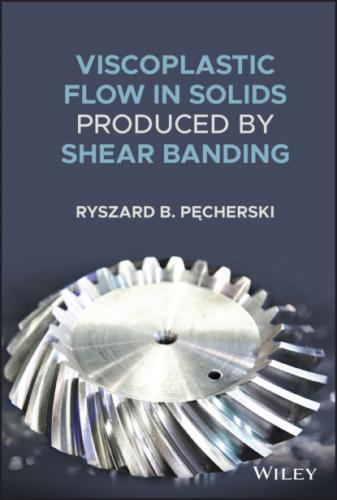Library of Congress Cataloging‐in‐Publication Data
Names: Pęcherski, Ryszard B., author. | John Wiley & Sons, publisher.
Title: Viscoplastic flow in solids produced by shear banding / Ryszard B. Pęcherski.
Description: Hoboken, NJ : Wiley, 2022. | Includes bibliographical references and index.
Identifiers: LCCN 2022010729 (print) | LCCN 2022010730 (ebook) | ISBN 9781119618584 (cloth) | ISBN 9781119618607 (adobe pdf) | ISBN 9781119618638 (epub)
Subjects: LCSH: Shear (Mechanics). | Deformations (Mechanics). | Viscoplasticity.
Classification: LCC TA417.7.S5 P44 2022 (print) | LCC TA417.7.S5 (ebook) | DDC 620.1/1245–dc23/eng/20220408
LC record available at https://lccn.loc.gov/2022010729 LC ebook record available at https://lccn.loc.gov/2022010730
Cover Design: Wiley
Cover Image: © Sergey Ryzhov/Shutterstock
I am devoting this work to the memory of my late parents, both teachers. My mother, Kazimiera Natalia de domo Rogala. My father, Bolesław lycée mathematician, enjoyed sharing knowledge and an extensive math library with me.
I also want to express my extraordinary feelings directed to my late grandpa Antoni Rogala. He was ‘guiding my pen’ with his wit and imagination. The stories of his life in the turbulent times of the last century become enlightening examples of a positive attitude towards difficult situations.
Preface
The thorough Investigations of the new types of materials – nano‐ and ultrafine‐grained metallic solids, amorphous metal alloys called glassy metals, and high‐performance alloys – lead to an essential general conclusion. Observing their failure processes, one may notice that a paradigm shift transpires before our eyes regarding the widely known and accepted ductile failure micromechanisms as initiation, growth, and coalescence of voids. The recent nonstandard experiments confirm the novel observations about the vital importance of accompanying shear modes, e.g. stereo digital image correlation, the tomograms of X‐ray, or synchrotron techniques related to 3D imaging methods. Dunand and Mohr (2010), using two‐ and three‐dimensional digital image correlation technique, measured the surface strain fields on tensile specimens, including the one with a central hole and circular notches. The samples came from TRIP780 steel sheets. The authors concluded that the non‐porous plasticity model's numerical predictions agree well with all macroscopic measurements for various loading conditions. Dunand and Mohr (2011) studied for TRIP780 steel the shear‐modified Gurson model's predictive capabilities (Nielsen and Tvergaard 2010) and the modified Mohr–Coulomb fracture model (Bai and Wierzbicki 2008). The result is that significant differences between the two models appear with the less accurate prediction for the shear‐modified Gurson model. Gorij and Mohr (2017) present a new micro‐tension and micro‐shear testing technique applying aluminium alloy 6016‐T4 flat dogbone‐shaped, as well as notched and central hole samples and smiley‐shear micro‐specimens to identify the parameters of hardening law and fracture initiation model. The Hosford–Coulomb damage indicator model predicts the ductile fracture initiation that appears imminent with the onset of shear localisation.
It became then evident that the known porous material models, e.g. by Shima et al. (1973), Shima and Oyane (1976), or Gurson (1977) extended by Tvergaard and Needleman (1984), reveal limited applications besides the cases when high triaxiality states are prevalent. Therefore, the studies of inelastic deformation and failure of materials should require, in my view, a fresh and novel approach. It aims towards a better understanding and description of the multilevel character of shear deformation modes. It is also worth stressing that Pardoen (2006) emphasizes the role of shear localisation in low‐stress triaxiality ductile fracture.
The known experimental data reveal that metallic solids' inelastic deformation appears in the effect of competing mechanisms of slips, twinning, and micro‐shear banding. Shear banding is a form of instability that localises large shear strains in relatively thin bands. The micro‐shear bands transpire as concentrated shear zones in the form of transcrystalline layers of the order 0.1 μm thickness. The observations show that a particular micro‐shear band operates only once and develops rapidly to its full extent. The micro‐shear bands, once formed, do not contribute further to the increase of inelastic shear strain. Thus, it appears that successive generations of active micro‐shear bands, competing with the mechanisms of multiple crystallographic slips or twinning, are responsible for the inelastic deformation of metals. Therefore, identifying the physical origins of the initiation, growth, and evolution of micro‐shear bands is fundamental for understanding polycrystalline metallic solids' macroscopic behaviour.
A new physical model of multilevel hierarchy and evolution of micro‐shear bands is at the centre of this work. An original idea of extending the representative volume element (RVE) concept using the general theory of propagation of the singular surfaces of microscopic velocity field sweeping the RVE appears useful for the macroscopic description of shear‐banding mechanism in viscoplastic flow, cf. Pęcherski (1997, 1998). The essential novelty of the presented approach comes from numerous observations revealing that the process of shear banding is the driving factor – a cause and not a result. So it turns out, in my view, that the successive generations of micro‐shearing processes induced mostly by changing deformation path produces and controls viscoplastic flow. On the other hand, one may recall many valuable papers containing the results of in‐depth analysis, modelling of dislocation‐mediated multi‐slip plastic deformation, and numerical simulations of the laminate microstructure, bands, or shear strain localisation in crystalline solids cf. Dequiedt (2018), Anand and Kothari (1996), Havner (1992), as well as Petryk and Kursa (2013) and the wealth of papers cited herein.
Recent studies reveal that two types of shear banding, generating the inelastic deformation in materials, can play a pivotal role.
The first type corresponds to the rapid formation of the multiscale shear‐banding systems. It contains micro‐shear bands of the thickness of the order of the 0.1 μm, which form clusters. The clusters propagate and produce the discontinuity of microscopic velocity field vm. They spread over the RVE of a traditional polycrystalline metallic solid. A detailed discussion of such a case is presented in Pęcherski (1997, 1998). A new concept of the RVE with a strong singularity
